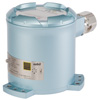Spectral intensity (SI)
Spectral intensity (SI) is an indicator of earthquake intensity. It quantifies the size of the response by buildings, such as homes and factories, to an earthquake.
- Clarification of Correlation with Damage to Homes and Factories and with Seismic Intensity as Measured by the Meteorological Agency
- Quick Evaluation of Earthquake Impact Helps to Prevent Secondary Disasters

Clarification of Correlation with Damage to Homes and Factories and with Seismic Intensity as Measured by the Meteorological Agency
In recent years, earthquakes have caused damage around the world, making people realize the dreadful power of natural disasters.
Today, we use several measures to tell the intensity of earthquakes. Japan has its own seismic scale of zero to seven, which indicates the amount of shaking (shindo) from the earthquake at points on the ground. Another system, the magnitude scale, indicates the amount of energy released by an earthquake. General seismometers measure the acceleration of ground and building motions.
SI is another such measure, and indicates how much an ordinary building will be damaged by an earthquake. Homes, commercial buildings, and factories have a characteristic natural frequency of vibration. The probability of damage is high if vibration continues at this frequency. Using this natural frequency, the velocity at the peak response of the building (velocity response spectrum) can be calculated. SI is defined as the mean value of the velocity response spectrum.
SI was first suggested in 1961 by an American seismologist, George W. Housner. Housner’s spectral intensity reappeared in the spotlight a half century later when it was discovered that there is a high correlation between SI and the actual level of damage to buildings.
Analysis of the correlation between past measurements of earthquakes and the actual damage they caused has revealed that it is not always true that the higher the acceleration (the measure widely used today), the greater the damage. On the other hand, it was found that the majority of buildings were actually damaged when the SI measured over about 30 kine (cm/s). So, SI has increasingly been accepted as an indicator of the impact of earthquakes.
Quick Evaluation of Earthquake Impact Helps to Prevent Secondary Disasters
Of course, SI is not accurate enough to tell the exact size of an earthquake. However, if we know the size of an earthquake with a certain level of accuracy, it is easier for us to keep damage to a minimum and to take action to prevent secondary damage.
SI has already been used to make decisions as to whether or not to stop operation at factories and various types of essential infrastructure when an earthquake strikes. For example, facilities that handle dangerous substances, such as chemical plants, are strongly urged to stop operation quickly and safely when a dangerous situation like a fire, explosion, or discharge of hazardous substances is predicted. By installing an earthquake sensor that calculates SI and embedding a system that automatically stops facility operation when the value exceeds predefined criteria, we can reduce delays in the initial response to a dangerous situation. Likewise, using SI, which has a high correlation with possible damage, will reduce the risk of unnecessary shutdowns.
In Japan, gas companies, waterworks, railroads, and others have increasingly been using SI to make important decisions such as whether to stop supplying gas or water and whether to stop train operation.
In the future, as the range of applications of SI expands, and as its usefulness as an indicator for use in disaster prevention measures is increasingly recognized, we can expect that society will become better able to cope with earthquakes.

